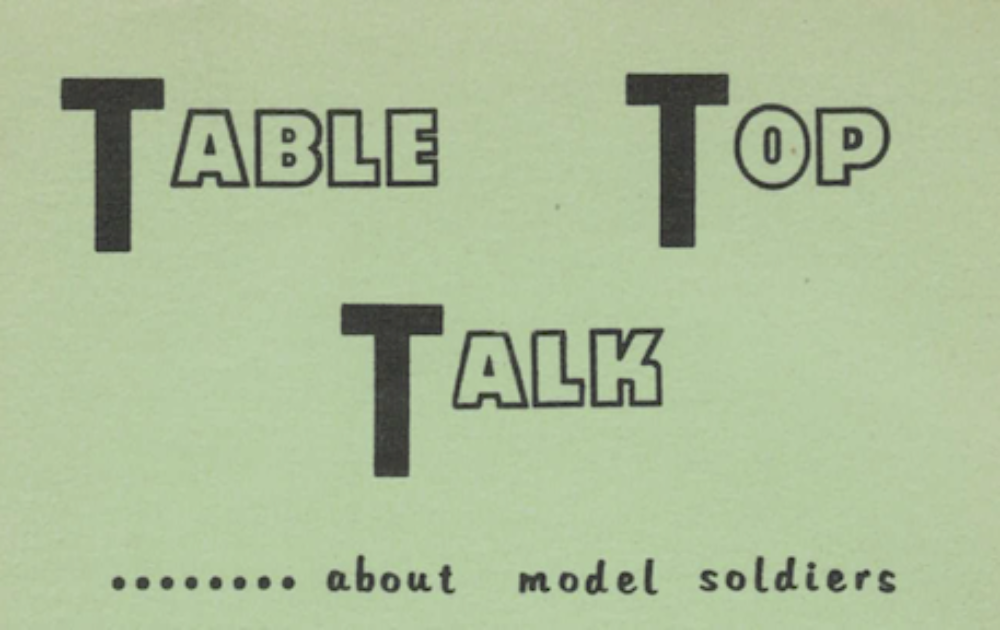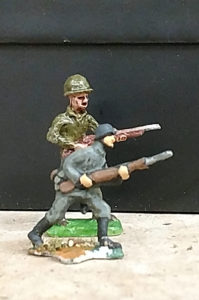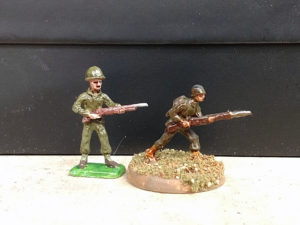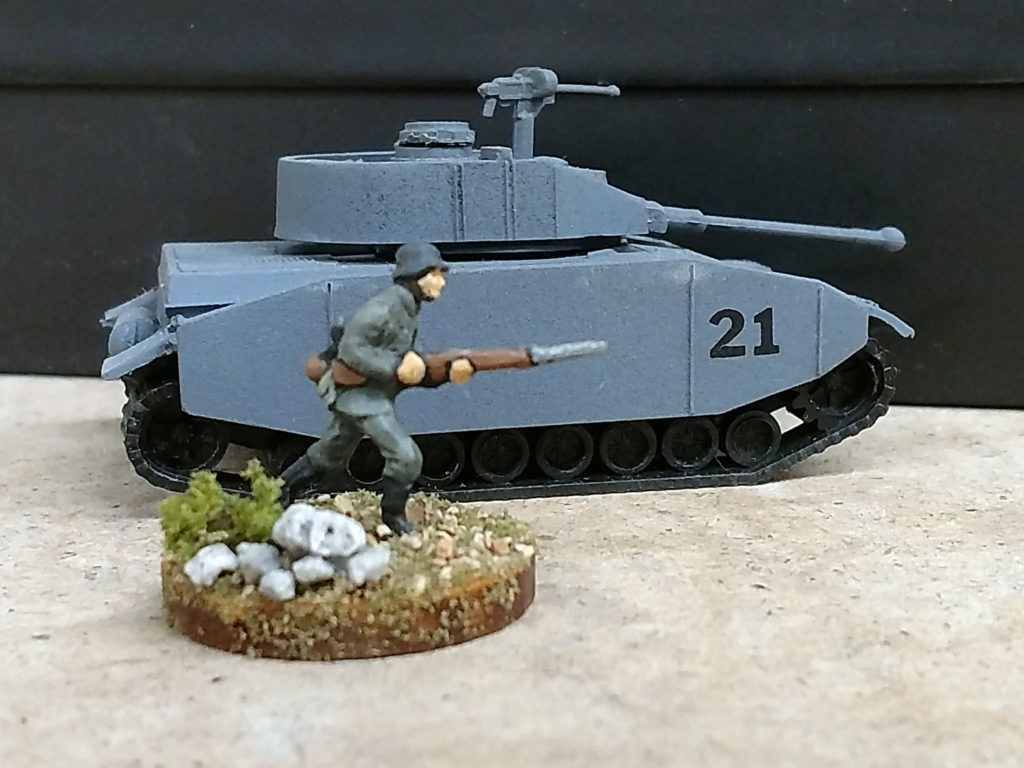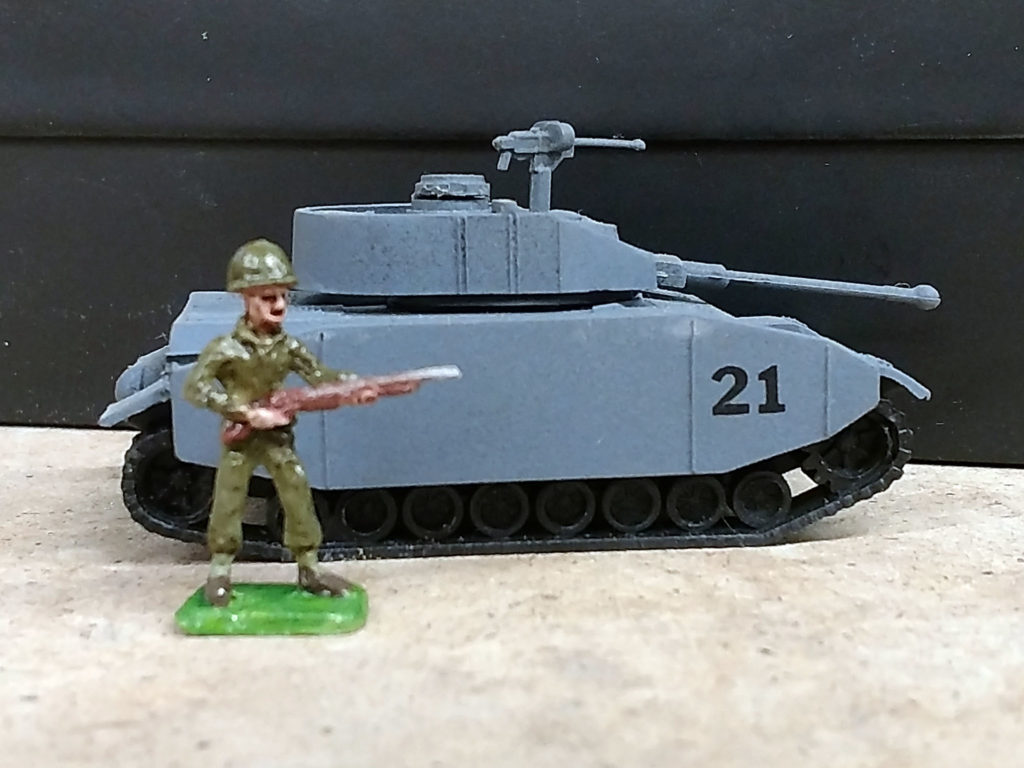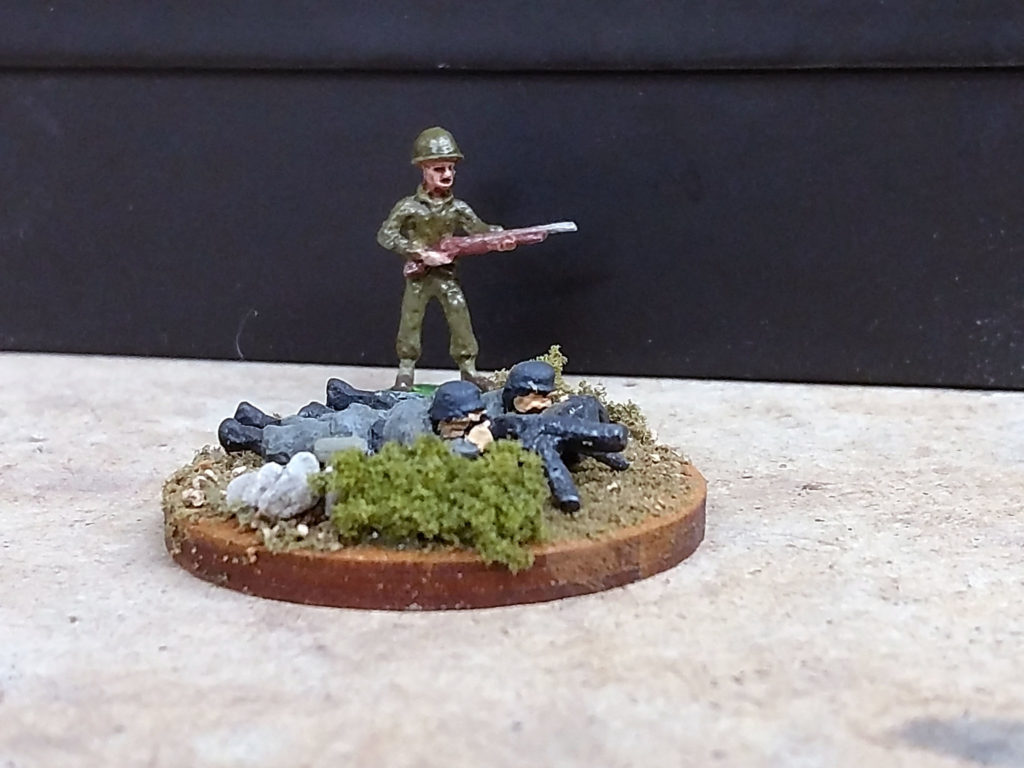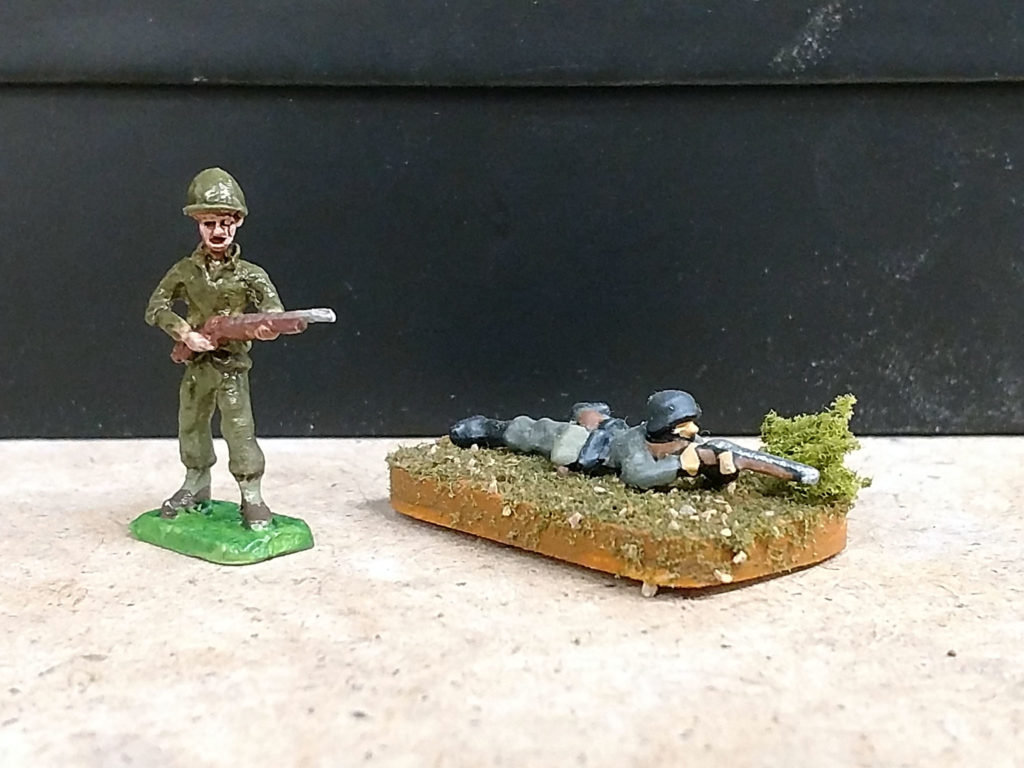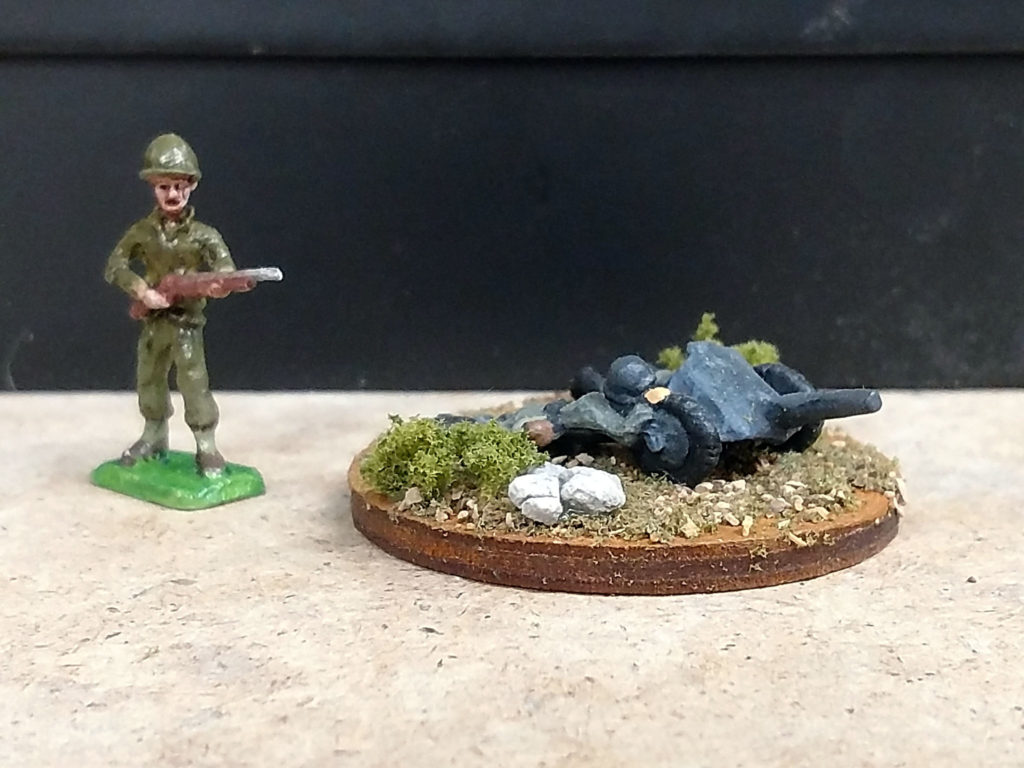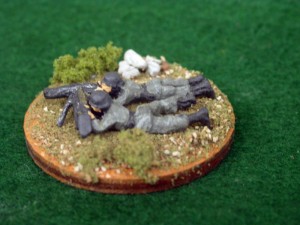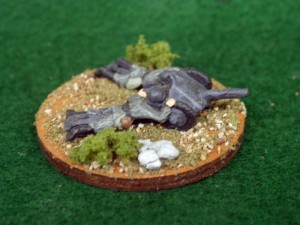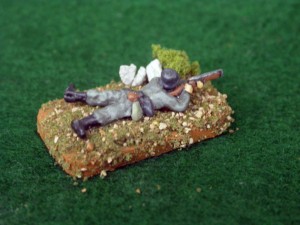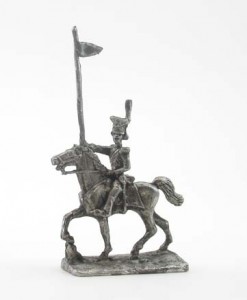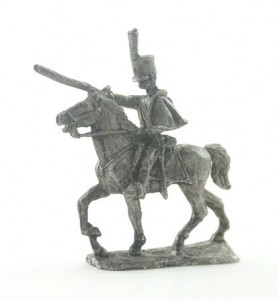Today, we step back in time to 1957. Our topic for today is Modern Warfare in miniature, as practiced in 1957 by A.W. ‘Ed’ Saunders of Somerset England.
At the time of [original] publication Ed was a 39 year old, married truck driver with a 9 year old son named Alan. Previously, Ed served in the R.A.F. from 1939 until the latter part of 1945.
Ed started collecting miniatures in 1946 and shortly thereafter decided on a single figure collection of the Napoleonic era. Starting with conversions of manufactured figures he soon turned to the making of miniature figures of his own design. Once Ed started making his own figures he made them in every period imaginable.
From his early days of figure collecting, Ed was intrigued by War Games. His first attempts at war games had him hooked! His thinking was that it was a logical use in which miniature soldiers should be employed. Ed’s early war game reporting appeared in The British Model Soldier Society Bulletin (issue unknown, but I am researching) where he reported on his war games played with 54mm soldiers in the garden (18′ x 24′). From there his games moved indoors, eventually building up his 18mm Russian-German forces (be sure to look for a battle report in the near future).
Did you know that these same 18mm (we call them 20mm) figures are available from HistoriFigs? For figure listings please visit the HistoriFigs website.
I suspect that Ed’s rules are the genesis of the Lionel Tarr (Tarr and Saunders were cousins) / Carl Reavley rules which were developed between 1958 and 1962. Look for Carl Reavley’s rules (SANTAT, Sand Table Tactics) to appear here in the near future (as soon as the OCR and editing can be completed). For Lionel Tarr’s rules see John Curry’s book: More Wargaming Pioneers Volume 4. In the spring we shall preset an analysis/comparison of the three (Saunders, Tarr and Reavley) rules sets.
Rules for Modern War Games
by A.W. Saunders
War Game Digest, September 1957
When I first attempted a modern war game using those excellent little 18mm Authenticast figures – I used first of all only three tanks and one self propelled gun for each side. After this game, I was determined to use more tanks, and to find better rules which would take into account the good and bad points of various types of armoured vehicles.
This scheme was given some impetus by the arrival of some Authenticast tanks from collector friends in the US. I made rubber molds of these, and cast them in plaster, and then converted them into various types of self propelled guns anti-tank, field guns and howitzers. In all, I turned out 72 AFVs, all of the 1939-45 war and Russian and German in origin.
Before going into the means I eventually worked out for firepower of these various tanks, it is perhaps best now to state the basic rules which are necessary for Modern War Games. The following rules have only to do with the movement of infantry and the rules necessary to play the game.
Basic Rules for Any Land Warfare Game
1 One dice is used to compute casualties; a throw being given for each-6 infantry that bring fire to bear. Similarly for any tank, gun, siege weapon, etc.
a – It is advisable to move troops in sections of six, keeping each section slightly apart from one another. This is a great help when firing takes place.
2 When firing takes place, do this section by section; first of all throwing the dice to see which section fires first.
a – A player having more sections firing than his opponent, will thus have additional firepower without return fire.
b – The only exception is when flanking fire is brought to bear, in which case the force outflanking the enemy always fires first.
3 Moves will be simultaneous, each commander moving from his left. This rule must be strictly adhered to, and any troops not moved cannot be moved afterwards.
a – If during his move, a commander comes across troops, which or owing to the movement of the enemy, are in close combat (melee or hand to hand) he cannot move these until the issue is decided, and must leave these troops in position until the fighting commences.
4 If a section of troops is less than the usual six, the casualties it can cause are decided as follows:
a – Subtract from the dice throw, the number of troops it is short of six. Example: four soldiers fire; the dice throw is three. Subtract 2 from 3. Casualties are 1.
5 Casualties are halved when cover is taken advantage of.
a – Even though a soldier will always be standing, if cover is available which a soldier would normally take advantage of, by laying down, or kneeling, it is considered as cover.
6 In certain cases a double move may be used as follows:
a – If charging. In this case, the troops must be within small arms range, and terrain must be suitable for a charge.
b – If running away after losing in combat, either a firefight, or hand to hand conflict.
c – If desiring to get under cover if artillery has the range and is causing casualties.
7 Melee (or hand to hand fighting)
a – A simultaneous throw of the dice by both players, for each six men involved. Casualties thus made will be halved.
b – Then a throw of the dice for each six men surviving the first throw.
c – Highest total then wins, with loser running away.
8 Troops under cover, and not returning fire, will suffer no casualties from small arm fire.
9 The first 16 moves will be considered in daylight; the next 8 moves will be at night.
a – At night, small arms fire will be cut down to 6 inches range.
10 Off the Table Moves (for night movement or if Concealment rules are used)
a – Each commander is supplied with a board marked into squares, each square representing one square foot of the table, and the whole board representing the war game table.
b – Each square has a hole drilled in it to take a cardboard counter which has a wooden peg on the underside of it.
c – On these counters are marked troop formations, which should be such that the actual troops represented would take up no more room on the table than is physically possible.
d – These off the table units may be moved one square in any direction on each move, thus making it easy for each player to account for his troops, and be able to bring them into action at the proper position on the table.
e – These movements are of course made in secret.
11 Machine guns get one throw of dice to determine casualties.
12 Artillery Rules:
a – All fire considered direct fire as is fire of anti-tank guns
b – Howitzer or mortar fire · Must throw a 4 or over, then will be on target.
c – Ranges will vary as the player desires, but some suggested ranges will appear later in this article.
13 Minefields (as suggested by my 9 year old son, Alan)
a – These can be set up in secret by using the square board as suggested in Rule 10. The mine fields would be thus one square foot on the table, and can be marked with the counters on the board.
b – Can use two types of minefields, anti-tank and anti-personnel.
14 Trenches – an infantryman can dig one inch of trench in three moves (This for 18mm troops; player can scale this to his troops)
a – Barbed wire, abattis, etc. can be placed in front of the trench in two moves. This would slow down enemy troops one move to get over the entanglements.
b – In the case of a loop-holed trench, or earth work system defensive casualties would be cut down to one quarter of the opponents dice throw.
In general, in all Modern War Games, the basic rules listed above will be followed out by the players. However besides, the infantryman, we have our armoured vehicles, tanks, bazookas, and airplanes. It all sounds complicated, perhaps, but after much “sweat and tears” I have worked out a highly successful and efficient method of computing firepower and armour value for mechanized equipment that makes the game a simple, interesting war game to play.
Despite the fact that we use plenty of tanks in our games, it gets down to the infantryman in the last analysis who is the man who gets, and holds the ground.
Additional Rules for Modern War Games
Basic Rules
1 Rifle and machine gun fire is 24 inches (on a 10ft by 5ft table)
2 Fire from all weapons is direct fire, except self·propelled field artillery.
3 For indirect fire, a 4 or more must first be thrown to get on target. Then a throw.is made to compute casualties. Once the target is ranged a 4 is not needed again unless the target moves.
4 Machine guns always fire first. A 6 is needed to knock them out, unless overrun by tanks or infantry attack.
5 Each Armoured Fighting Vehicle will have one throw of the dice per move. Unless within small arms range (24 inches) tank fire causes only half casualties to infantry.
6 In all cases of infantry sections and AFV fire, the dice are thrown to see who gets first shot.
Airplanes
1 Airplanes will always be moved last. The moves of these will be checked by means of coloured pegs in a small peg board with holes corresponding to the range of the plane. Each aircraft will have its colour on spinner, wings and fuselage. when peg is moved into the second hole, the airplane will move on to the edge of the table. Must be back on to the edge of the table when this hole is reached again.
2 A plane cannot turn at more than right angles. Its move is 36 inches but may move 24 inches if desired. When turning, it will move half a move straight ahead, then half a move at right angles.
3 If flak is used, it will come under fire in the normal manner. If flak not used, will be under fire for each move it is over enemy troops. A 5 or 6 needed to bring the plane down.
4 Airplane gun values (to be used with tables following)
a – Rocket – 6 points – range of 24 inches.
b – Bomb – 6 points.
c – Cannon – 2 points – range of 24 inches.
Armoured Fighting Vehicles
1 All AFVs will have marked on them the following information:
a – The gun value – on the turret or superstructure
b – The armour-speed value – on the hull.
c – Speed and gun range – on the underside of the AFV.
2 When AFVs are firing against each other, the player uses three dice, as follows:
a – To reach total to destroy an AFV, subtract the gun value of the AFV that is firing, from the armour-speed value of the target.
b – The player rolls three dice. The total points must add up to the difference between gun value and armour-speed value to destroy the target AFV.
c – Add 2 points to the armour-speed value if tank in cover, or for a frontal shot.
d – Add 2 points to the gun value if shot at flank, top, or rear of AFV target.
Thus, after a number of trials and errors, the easy method of determining AFV casualties was worked out as mentioned above. All one has to do to determine firepower and armour value is look at the vehicle, and it is all written there for the player to see. One can take care in painting on these numbers, and it then appears almost as if it were the actual AFV’s numerals. Thus, the biggest problem of fire between vehicles, was solved in a simple manner, and the main drawback to the game is eliminated.
Now it is only necessary to work out the relative power of each vehicle, along with its armour·speed values. This, I worked out for Russian and German tanks of the 1939-45 War. The war game general interested in modern warfare will have no trouble working out his own values for other countries tanks and these can easily be divided into heavy, medium and light tanks.
|
Vehicle
|
Gun Value
|
Armour-Speed
|
Gun Calibre
|
Gun Range
|
Speed
|
|
Royal Tiger
|
6
|
18
|
128mm
|
50
|
6
|
|
Tiger
|
5
|
17
|
88mm
|
40
|
8
|
|
PZKW4
|
4
|
15
|
75mm
|
36
|
11
|
|
PZKW3
|
3
|
14
|
47mm
|
30
|
13
|
|
Howitzer on PZKW3
|
3
|
12
|
105mm
|
50
|
14
|
|
Assault Gun on PZKW3
|
2
|
12
|
75mm
|
40
|
15
|
|
T35 Light Tank
|
2
|
13
|
37mm
|
24
|
14
|
|
Armoured Car
|
2
|
10
|
20mm
|
24
|
24
|
|
Bazooka
|
2
|
|
|
12
|
|
From the tables above you can see that the heavy tanks have more armour-speed value, and this would be true of any tanks of any country. By the time a frontal armour of 2 extra points is added to the armour value, these tanks are hard to knock out, unless caught on the flank, where 2 points are deducted.
You will note also the ranges of the various guns, and should easily be able to adapt this to your own forces AFVs. Actually the size of the gun also determines the gun value of the vehicle, and in general all firepower and range therefore will depend on the weapon the tank is equipped with. Remember also, these ranges are based on my 10ft by 5ft table, and from this you can work down the ranges to the scale you are equipped to fight on.
I have not used towed anti-tank guns, even though Authenticast builds a nice two man set of these. However these would be given the same gun value and range of a bazooka.
Since developing the above scheme which works so successfully, it has occurred to me that a similar points system could easily be used in other games. For instance a Medieval War Game. One could give knights a points value for skill at arms to be subtracted from the armour value of any opposing knight or man at arms.
It also is in my mind to·use a larger soldier for use in a game where the tactical unit.would.be only at company strength – say 50 men. Soldiers here would take on an individuality according to their combat experience., They could be graded as Veterans (still fresh), Combat Weary Veterans and Replacements . Each type would be given combat points value for his marksmanship, this to be subtracted from the combat value of his targets Such games would not be full scale battles, but only such as would fall to the lot of a Company.
– A.W.S.
